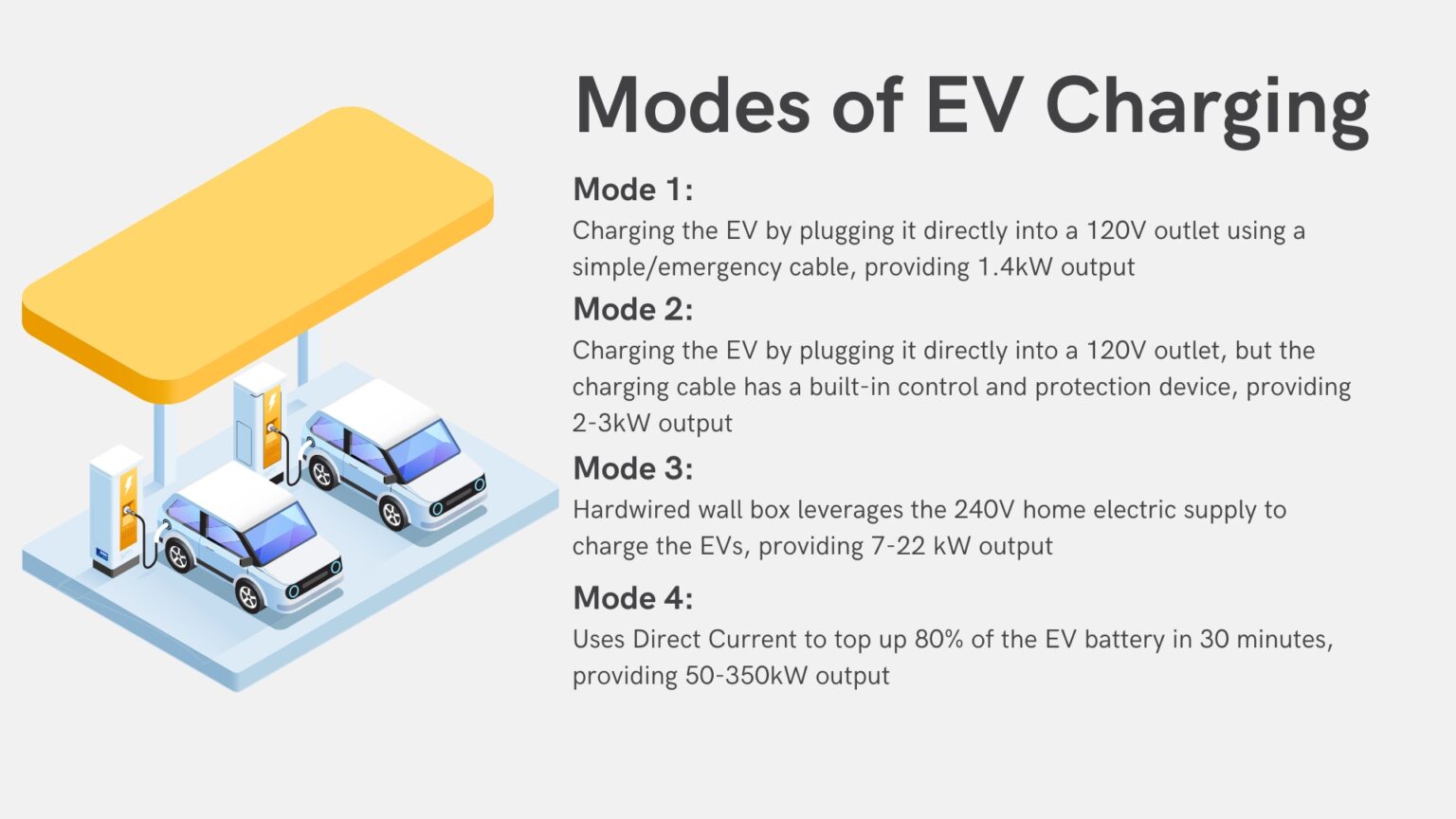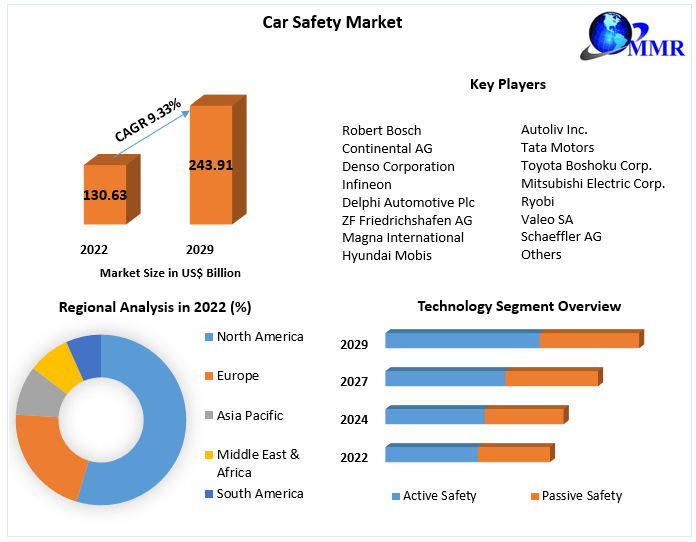Electric vehicles are revolutionizing personal transportation by offering a sustainable alternative to gas-powered cars. But learning about EV charging can seem daunting at first, like learning a new language. To help make the transition to driving electric feel easier, let’s explore the main ways EVs can power up.
In this guide, we’ll break down the primary charging modes available for electric vehicles today. We’ll discuss how each method works in simple terms, key benefits, and when it excels. EV charging modes explained in everyday language – let’s hit the road!
What are the Different EV Charging Modes?
There are four main charging modes that keep electric vehicles running. All bring different features to the table in terms of charging speed and real-world use. Let’s check out what makes each charging mode unique:

Mode 1 Charging
Mode 1 charging is the most basic method of charging an electric vehicle. It involves plugging the EV directly into a standard 120V AC electrical outlet in homes and buildings using the charging cable supplied with the vehicle. Given that the maximum power output from residential wall outlets in North America is 120V at 12 amps or 1.4 kW, Mode 1 provides an extremely low-power charge. Charging speeds are very low, with such a minimal level of only 1.4 kW being transferred. A vehicle receiving a Mode 1 charge will typically only see a range increase of 2-5 miles per hour of charging.
Due to this minimal power output, a full battery charge using Mode 1 can take 20 hours or more, depending on the vehicle and initial state of charge. This long charging time makes Mode 1 impractical for daily use. It would not provide drivers with a sufficient charge overnight or during a typical work day to be usable as a primary fueling method.
Safety is also a limitation without a dedicated charging circuit or communication between the vehicle and the outlet. There is the potential for electrical shock or overload without proper regulation and circuit grounding.
Bottomline:
Given its slow charging speeds and safety downsides, we do not recommend Mode 1 for regular vehicle charging needs. The minimal benefit it provides in range per hour also means more time for charging and less for the road. You can only use it to occasionally “top off” a battery after substantially charging your EV via level 2 or DC fast charging.
Even as a backup option, You should use Mode 1 only when absolutely necessary, and it is generally not part of typical daily electric vehicle routines as some countries have banned it owing to safety issues.
Mode 2 Charging
Mode 2 charging takes the primary approach of Mode 1 and builds on it by incorporating essential safety features. Mode 2 utilizes the same 120V AC residential power outlets but includes a control and protection device within the dedicated charging cable. Also, the charging station is mobile and not hardwired into the electrical supply of your house.
This onboard control pilot setup establishes communication between the vehicle and outlet through proprietary signaling. It allows for monitoring of charging status and also provides critical ground protection against short circuits.
By integrating this intelligent control mechanism directly into the charging cable, Mode 2 charging enables a slightly faster rate than plain 120V Mode 1. When connected to a standard home outlet, the average charging rate typically hovers around 2-3 kilowatts, a notable improvement over the modest 1.4 kilowatts of Mode 1. Mode 2, owing to the additional kilowatts facilitated by the control pilot device, can enhance a vehicle’s driving range by an additional 5-10 miles per hour.
Bottomline
Despite the benefits over simple Mode 1, Mode 2 charging still remains relatively sluggish. A complete replenishment of a battery to 100% state of charge routinely takes 12 hours or more when using the 1.5-2 kW supply available through a general wall socket. As a result, Mode 2 fills more of an emergency backup function rather than serving as the main refueling method.
Many automobile manufacturers now include Mode 2 charge cables as standard equipment to provide drivers with at least a basic charging capability right out of the showroom.

Mode 3 Charging
Mode 3 charging represents a significant upgrade over Modes 1 and 2 by utilizing higher power 240V AC electricity. Mode 3 involves a professionally installed hardwired outdoor wall box. This wall box communicates directly with the home’s electric panel through dedicated high-current cabling to supply larger amounts of power safely and reliably. The wall boxes can output anywhere from 3.3 kW to as high as 22 kW, depending on the unit’s specifications and the configuration of your home power system.
Many Mode 3 chargers have the ability to tap into single-phase or three-phase current, allowing for charging rates between 7-19 kW. This capacity makes Level 2 (Mode 3) charging dramatically faster than the paltry speeds of Modes 1 and 2. Mode 3 pushes the charging time down substantially by leveraging the higher 240V that most households have available but can’t be used by Mode 1 and Mode 2. A full battery replenishment using a Mode 3 wall box typically takes 4 to 8 hours, depending on the vehicle and charger power output.
Bottomline
Mode 3 ideally suits regular home or commercial use cases where your EV is parked for extended periods. The J1772 connector standard used across North American EVs ensures compatibility of the charger across multiple EVs. As a result, you’ll commonly see Mode 3/ Level 2 as a primary charging method for electric vehicle owners.

Mode 4 Charging
DC fast charging, known as Mode 4, represents the quickest method of recharging electric vehicle batteries. By converting high voltage alternating current on-site to direct current, fast chargers can charge at immense rates from 50 up to 350 kilowatts. Chargers deliver output voltage ranging from 400-600 volts to achieve these charging speeds. These rates allow you to add over 80% capacity to your EV in about a half hour, offering replenishment similar to gas fill-ups.
Fast chargers are located strategically at busy and prime spots because they need a sizable power infrastructure and electrical equipment. Therefore, you’ll mostly see them along highways and major thoroughfares or large parking areas. The on-board DC-DC converter and charging port hardware on newer EVs also allow them to take full advantage of public fast charging opportunities that few past vehicles could utilize.
Bottomline
The integrated vehicle’s charging system often restricts the amount of power it can process to prevent electrical hazards. However, the CCS Combo 1 and CHAdeMO connectors enable safe high-wattage transfer and compatibility. As electric driving expands, automakers are optimizing their vehicles to support faster Mode 4 charging on par with gasoline refueling for long treks.
Such rapid recharging, realizing 80% battery capacity in a mere 20-40 minutes, has transformed electric vehicle road-tripping viability and eased “range anxiety” barriers.

Choosing The Optimal Charging Method
Mode 1 and 2 AC charging is suitable for occasional or emergency charging scenarios but would be inconvenient for regular use due to very lengthy charge times.
Mode 3 chargers at homes or workplaces are ideal for everyday overnight charging missions. DC fast charging mode 4 reigns as the top option for rapid recharging during long-distance trips. With an understanding of EV charging modes, drivers can optimize battery charge levels for their daily commutes and travel routines.
Charging Equipment Components and Installation
Now that we understand the different EV charging modes, let’s explore the key components and installation considerations for each. Proper setup is important to ensure safety, reliability, and compliance with regulations.
Mode 1 and 2 only require a standard electrical outlet and charging cable. However, ensure that the outlet and wiring can handle the electric load, as overdrawing current can result in fire and shock hazards.
The equipment for Mode 3 chargers expands beyond the charging cable. The main wall box components include:
- Wall connector: Mounted securely to an exterior wall surface, the wall connector connects the vehicle and the home’s electric panel.
- Onboard vehicle charger: Integrated within the EV, it converts AC power from the wall box to DC for the battery pack.
- AC cabling: Hardwired cabling links the wall connector to the main electrical service panel. Cabling must meet national electric codes.
- Wallbox display: Provides real-time charging status and notifications. EV drivers can access the charge settings via a smartphone app as well.
We highly recommend a professional installation for mode 3 systems. Electricians can assess the circuit capacity, install accordingly sized disconnects and breakers, run cabling according to the code, and configure optimal charge settings. Check with your local regulations to see if you require any charger installation permit.
Overcoming Charging Concerns
EV-olution is on the rise, but some people are still hesitant to make the switch. The following points will give you the reason and motivation you have been looking for:
- Range anxiety: Newer EVs regularly achieve 150-300 miles per charge, exceeding most commuters’ average daily driving distances. Ultra-fast chargers make 15-minute charges feasible for 80% battery boosts covering 100+ miles during occasional long-distance trips.
- Charging access: According to the U.S. Department of Energy, there are currently about 50,000 public EV charging stations in the U.S. Useful smartphone apps can now guide drivers to stations along any planned or spontaneous routes.
- Charging costs: Most EV drivers find their “fuel” costs dramatically lower than equivalent gas guzzlers, even after factoring in the cost of a home charger, labor, and the average national electricity cost. According to a 2020 study by the University of Michigan Transportation Research Institute, the average annual fuel and maintenance costs for electric vehicles were estimated to be just $485. This represents savings of over $630 per year compared to the roughly $1,117 it costs to fuel and service a gas-powered car doing similar driving.
- Time commitment: At home, vehicles charge automatically overnight when the electricity costs are also a bit low. This saves you time and money.
Take Away
Understanding the different electric vehicle charging modes empowers drivers to choose the optimal charging solutions. While Mode 1 and Mode 2 charging works for occasional top-ups, Mode 3 home charging provides the best overnight refueling. Mode 4/DC fast charging wins for rapid charging en-route.
With the right mix of charging modes, EV owners can keep their vehicles powered up for daily commuting as well as longer trips. As charging networks continue to expand, electric vehicles are becoming more practical than ever. Choosing chargers that fit your lifestyle helps smooth the transition to emission-free electric driving.
Read more info:- https://evchargerprime.com/ev-charging-modes-explained/







